Abstract
BACKGROUND: beta Agonists have been shown to increase mucociliary clearance in some studies but not all. Whether the formulation of beta agonists affects mucociliary clearance is not known but may be important as the use of dry powder inhalers increases. METHODS: The effect of different methods of administration of inhaled terbutaline on mucociliary clearance and forced expiratory volume in one second (FEV1) was assessed in 10 patients with asthma and 10 healthy subjects. Terbutaline (1 mg) was administered through a metered dose inhaler with a spacer (Nebuhaler) or a dry powder inhaler (Turbuhaler), or both treatments were given, in a four way double blind, double dummy trial. Mucociliary clearance was measured by bronchoscintigraphy. RESULTS: Clearance of radioactivity from the lobar bronchi increased in the asthmatic patients by a median of 32% after terbutaline was given by metered dose inhaler and 55% after a combined dose of 2 mg from both inhalers (1 mg from each) compared with placebo but by only 9% after 1 mg of terbutaline was given by a dry powder inhaler. In the healthy subjects mucociliary clearance increased by 51% when terbutaline was given by a dry powder inhaler, by 66% when given by a metered dose inhaler, and by 66% when given by both inhalers combined. The effect of terbutaline on FEV1 was the same with each of the inhalers. CONCLUSION: Despite similar changes in FEV1 with the two formulations terbutaline increased mucociliary clearance significantly in asthmatic and healthy subjects when inhaled from a metered dose inhaler whereas when it was inhaled from a dry powder inhaler its effect was significant only in healthy subjects. The reason for the difference in asthmatic subjects is unclear, but may be associated with differences in the deposition of terbutaline.
Full text
PDF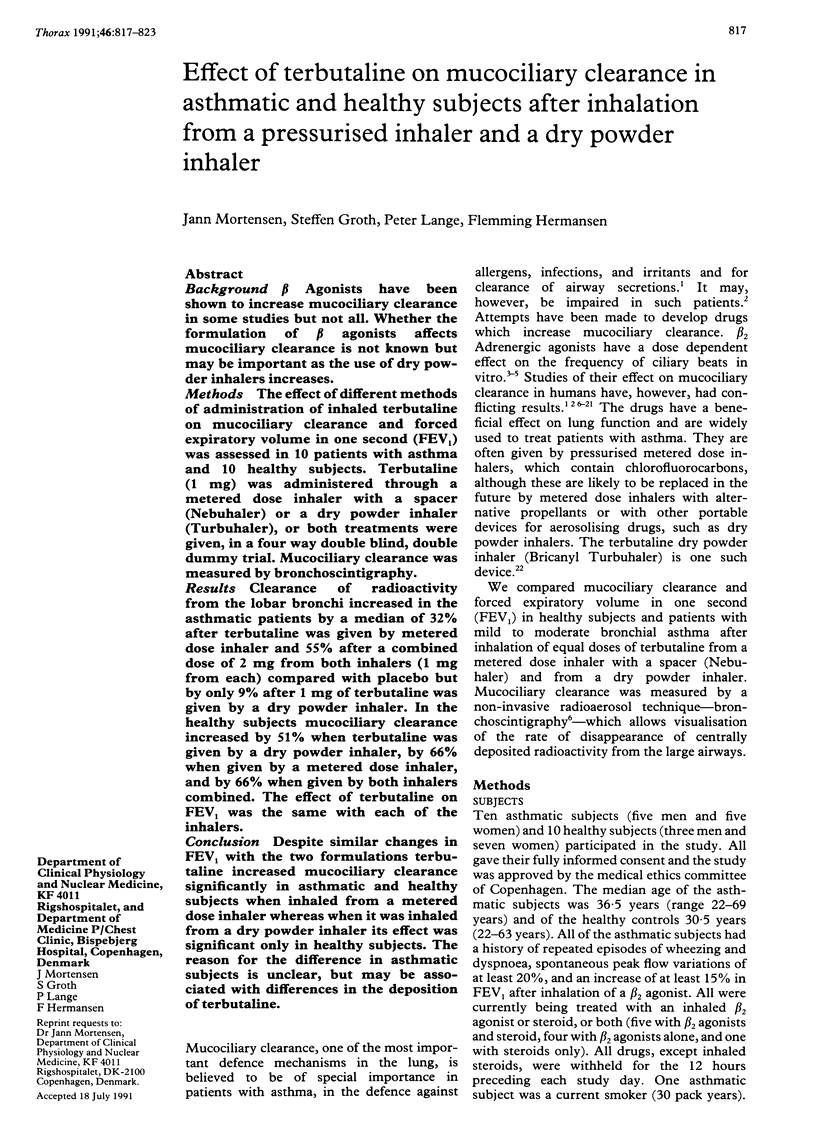
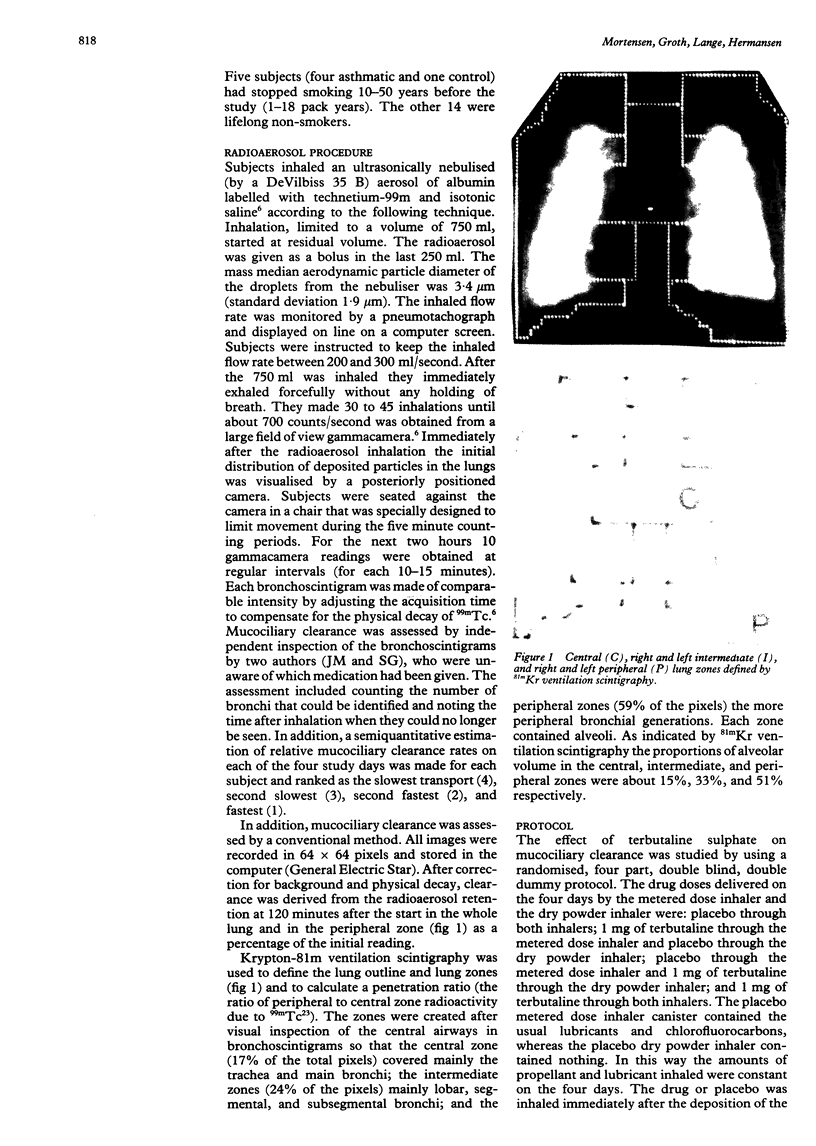

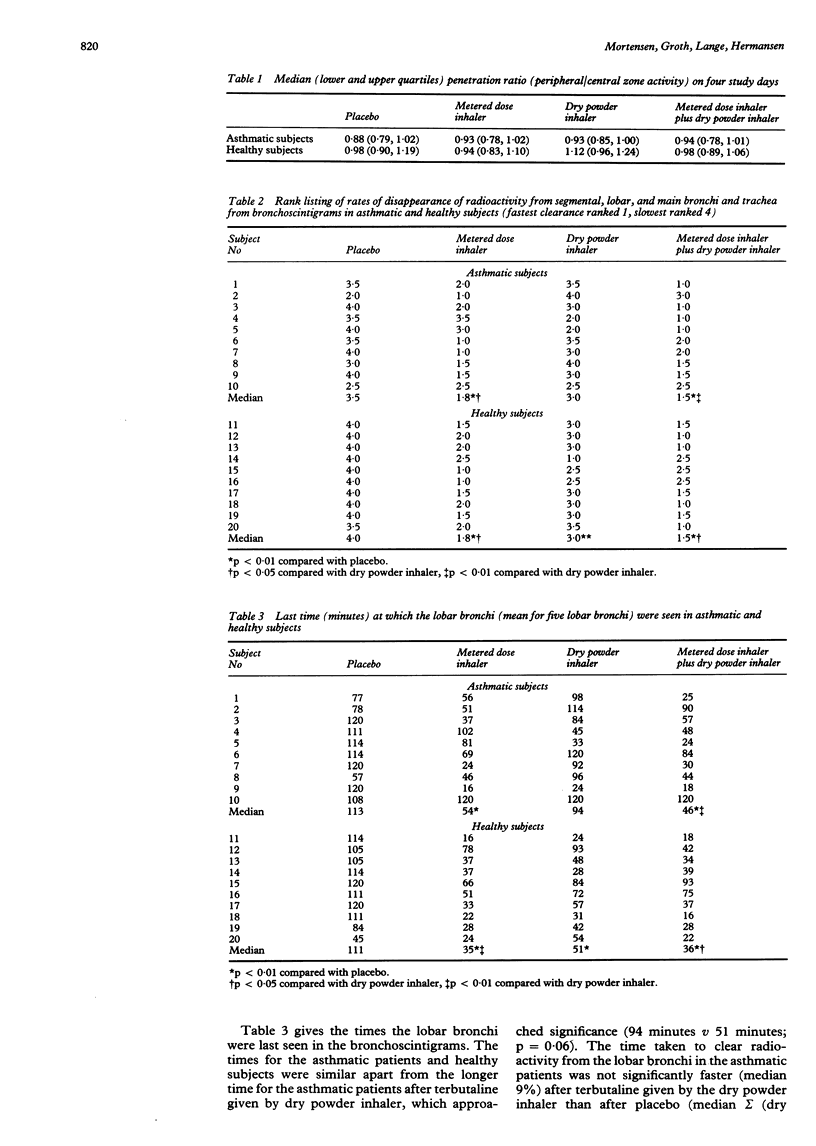
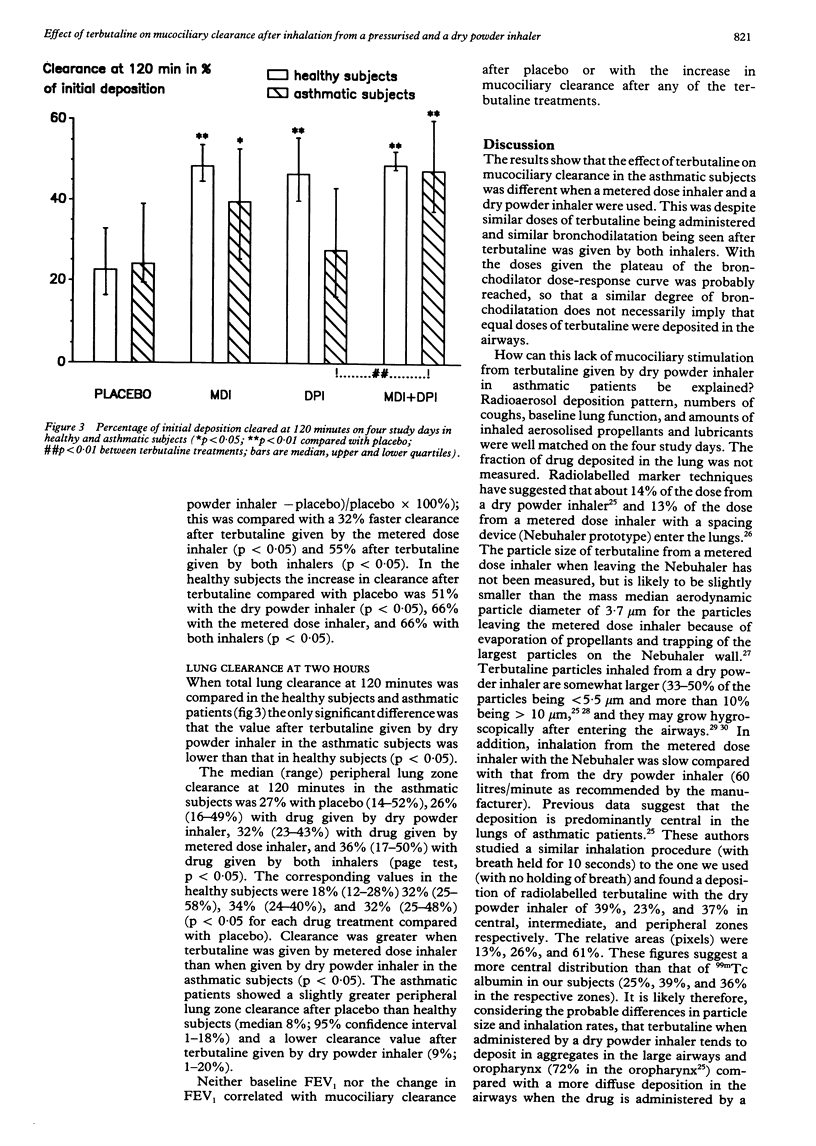
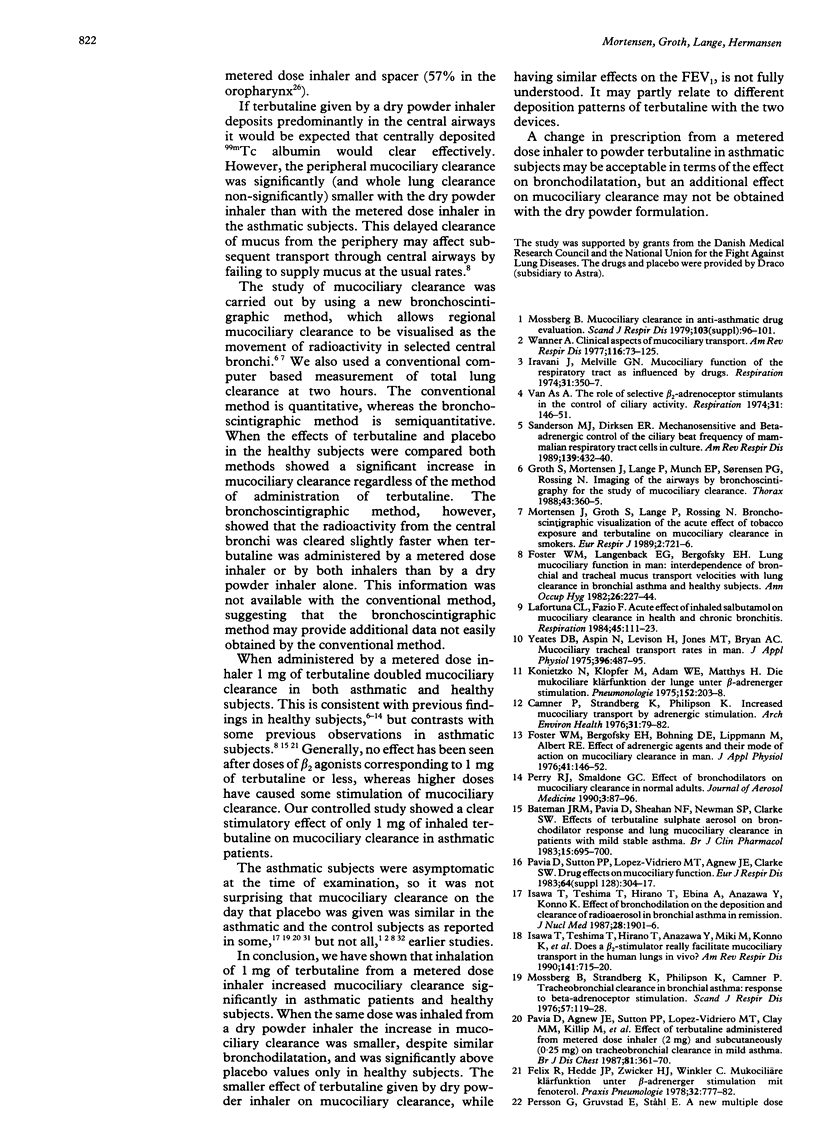
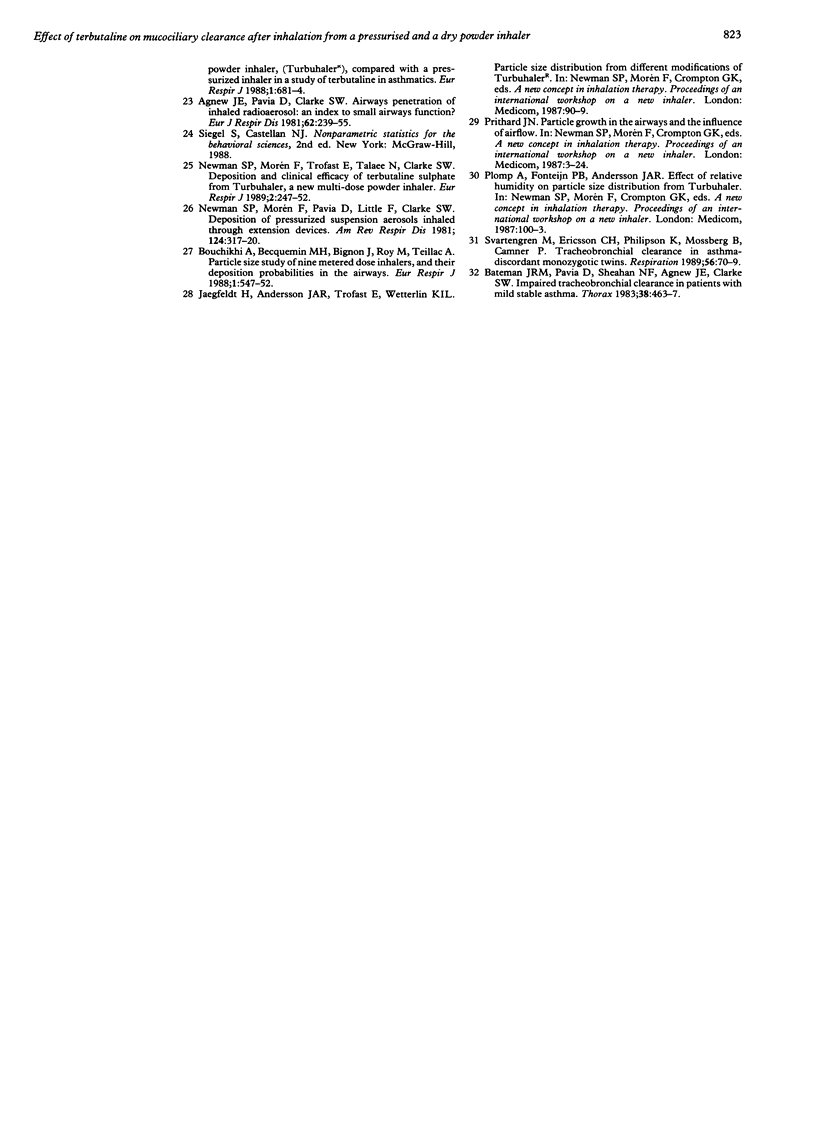
Images in this article
Selected References
These references are in PubMed. This may not be the complete list of references from this article.
- Agnew J. E., Pavia D., Clarke S. W. Airways penetration of inhaled radioaerosol: an index to small airways function? Eur J Respir Dis. 1981 Aug;62(4):239–255. [PubMed] [Google Scholar]
- Bateman J. R., Pavia D., Sheahan N. F., Agnew J. E., Clarke S. W. Impaired tracheobronchial clearance in patients with mild stable asthma. Thorax. 1983 Jun;38(6):463–467. doi: 10.1136/thx.38.6.463. [DOI] [PMC free article] [PubMed] [Google Scholar]
- Bateman J. R., Pavia D., Sheahan N. F., Newman S. P., Clarke S. W. Effects of terbutaline sulphate aerosol on bronchodilator response and lung mucociliary clearance in patients with mild stable asthma. Br J Clin Pharmacol. 1983 Jun;15(6):695–700. doi: 10.1111/j.1365-2125.1983.tb01552.x. [DOI] [PMC free article] [PubMed] [Google Scholar]
- Bouchikhi A., Becquemin M. H., Bignon J., Roy M., Teillac A. Particle size study of nine metered dose inhalers, and their deposition probabilities in the airways. Eur Respir J. 1988 Jun;1(6):547–552. [PubMed] [Google Scholar]
- Camner P., Strandberg K., Philipson K. Increased mucociliary transport by adrenergic stimulation. Arch Environ Health. 1976 Mar-Apr;31(2):79–82. doi: 10.1080/00039896.1976.10667194. [DOI] [PubMed] [Google Scholar]
- Felix R., Hedde J. P., Zwicker H. J., Winkler C. Mukoziliäre Klärfunktion unter beta-adrenerger Stimulation mit Fenoterol. Prax Klin Pneumol. 1978 Dec;32(12):777–782. [PubMed] [Google Scholar]
- Foster W. M., Bergofsky E. H., Bohning D. E., Lippmann M., Albert R. E. Effect of adrenergic agents and their mode of action on mucociliary clearance in man. J Appl Physiol. 1976 Aug;41(2):146–152. doi: 10.1152/jappl.1976.41.2.146. [DOI] [PubMed] [Google Scholar]
- Foster W. M., Langenback E. G., Bergofsky E. H. Lung mucociliary function in man: interdependence of bronchial and tracheal mucus transport velocities with lung clearance in bronchial asthma and healthy subjects. Ann Occup Hyg. 1982;26(1-4):227–244. [PubMed] [Google Scholar]
- Groth S., Mortensen J., Lange P., Munch E. P., Sørensen P. G., Rossing N. Imaging of the airways by bronchoscintigraphy for the study of mucociliary clearance. Thorax. 1988 May;43(5):360–365. doi: 10.1136/thx.43.5.360. [DOI] [PMC free article] [PubMed] [Google Scholar]
- Iravani J., Melville G. N. Mucociliary function of the respiratory tract as influenced by drugs. Respiration. 1974;31(4):350–357. doi: 10.1159/000193595. [DOI] [PubMed] [Google Scholar]
- Isawa T., Teshima T., Hirano T., Anazawa Y., Miki M., Konno K., Motomiya M. Does a beta 2-stimulator really facilitate mucociliary transport in the human lungs in vivo? A study with procaterol. Am Rev Respir Dis. 1990 Mar;141(3):715–720. doi: 10.1164/ajrccm/141.3.715. [DOI] [PubMed] [Google Scholar]
- Isawa T., Teshima T., Hirano T., Ebina A., Anazawa Y., Konno K. Effect of bronchodilation on the deposition and clearance of radioaerosol in bronchial asthma in remission. J Nucl Med. 1987 Dec;28(12):1901–1906. [PubMed] [Google Scholar]
- Konietzko N., Klopfer M., Adam W. E., Matthys H. Die mukociliare Klärfunktion der Lunge unter beta-adrenerger Stimulation. Pneumonologie. 1975 Sep 26;152(1-3):203–208. doi: 10.1007/BF02101588. [DOI] [PubMed] [Google Scholar]
- Lafortuna C. L., Fazio F. Acute effect of inhaled salbutamol on mucociliary clearance in health and chronic bronchitis. Respiration. 1984;45(2):111–123. doi: 10.1159/000194607. [DOI] [PubMed] [Google Scholar]
- Mortensen J., Groth S., Lange P., Rossing N. Bronchoscintigraphic visualization of the acute effect of tobacco exposure and terbutaline on mucociliary clearance in smokers. Eur Respir J. 1989 Sep;2(8):721–726. [PubMed] [Google Scholar]
- Mossberg B. Mucociliary clearance in anti-asthmatic drug evaluation. Scand J Respir Dis Suppl. 1979;103:96–101. [PubMed] [Google Scholar]
- Newman S. P., Morén F., Pavia D., Little F., Clarke S. W. Deposition of pressurized suspension aerosols inhaled through extension devices. Am Rev Respir Dis. 1981 Sep;124(3):317–320. doi: 10.1164/arrd.1981.124.3.317. [DOI] [PubMed] [Google Scholar]
- Newman S. P., Morén F., Trofast E., Talaee N., Clarke S. W. Deposition and clinical efficacy of terbutaline sulphate from Turbuhaler, a new multi-dose powder inhaler. Eur Respir J. 1989 Mar;2(3):247–252. [PubMed] [Google Scholar]
- Pavia D., Agnew J. E., Sutton P. P., Lopez-Vidriero M. T., Clay M. M., Killip M., Clarke S. W. Effect of terbutaline administered from metered dose inhaler (2 mg) and subcutaneously (0.25 mg) on tracheobronchial clearance in mild asthma. Br J Dis Chest. 1987 Oct;81(4):361–370. doi: 10.1016/0007-0971(87)90185-9. [DOI] [PubMed] [Google Scholar]
- Pavia D., Sutton P. P., Lopez-Vidriero M. T., Agnew J. E., Clarke S. W. Drug effects on mucociliary function. Eur J Respir Dis Suppl. 1983;128(Pt 1):304–317. [PubMed] [Google Scholar]
- Persson G., Gruvstad E., Ståhl E. A new multiple dose powder inhaler, (Turbuhaler), compared with a pressurized inhaler in a study of terbutaline in asthmatics. Eur Respir J. 1988 Aug;1(8):681–684. [PubMed] [Google Scholar]
- Repo U. K., Nieminen P. Pulmonary infiltrates with eosinophilia and urinary symptoms during disodium cromoglycate treatment. A case report. Scand J Respir Dis. 1976;57(1):1–4. [PubMed] [Google Scholar]
- Sanderson M. J., Dirksen E. R. Mechanosensitive and beta-adrenergic control of the ciliary beat frequency of mammalian respiratory tract cells in culture. Am Rev Respir Dis. 1989 Feb;139(2):432–440. doi: 10.1164/ajrccm/139.2.432. [DOI] [PubMed] [Google Scholar]
- Svartengren M., Ericsson C. H., Philipson K., Mossberg B., Camner P. Tracheobronchial clearance in asthma-discordant monozygotic twins. Respiration. 1989;56(1-2):70–79. doi: 10.1159/000195780. [DOI] [PubMed] [Google Scholar]
- Wanner A. Clinical aspects of mucociliary transport. Am Rev Respir Dis. 1977 Jul;116(1):73–125. doi: 10.1164/arrd.1977.116.1.73. [DOI] [PubMed] [Google Scholar]
- Yeates D. B., Aspin N., Levison H., Jones M. T., Bryan A. C. Mucociliary tracheal transport rates in man. J Appl Physiol. 1975 Sep;39(3):487–495. doi: 10.1152/jappl.1975.39.3.487. [DOI] [PubMed] [Google Scholar]
- van As A. The role of selective beta2-adrenoceptor stimulants in the control of ciliary activity. Respiration. 1974;31(2):146–151. doi: 10.1159/000193106. [DOI] [PubMed] [Google Scholar]



